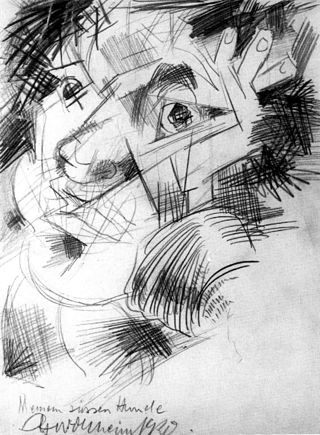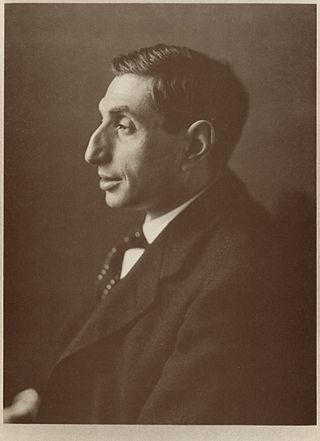

Heinrich Mathias Ernst Campendonk (3 November 1889 - 9 May 1957) was a painter and graphic designer born in Germany who became a naturalized Dutch citizen.


Heinrich Mathias Ernst Campendonk (3 November 1889 - 9 May 1957) was a painter and graphic designer born in Germany who became a naturalized Dutch citizen.
Campendonk was born in Krefeld, Kingdom of Prussia, German Empire. He was the son of a textile merchant, and served a textile apprenticeship until 1905. From 1905 to 1909, he received artistic education from Johan Thorn Prikker at the Handwerker- und Kunstgewerbeschule, a progressive school for arts and crafts. He became friends with Helmuth Macke , August Macke, Wilhelm Wieger, Franz Marc and Paul Klee during this time.
He was a member of the Der Blaue Reiter group from 1911 to 1912. When the Nazi regime came to power in 1933, he was among the many modernists condemned as degenerate artists, and prohibited from exhibiting. He moved to the Netherlands, where he spent the rest of his life working at the Rijksakademie in Amsterdam, first teaching Decorative Art, printmaking and stained-glass, then as the Academy Director. [1] He died as a naturalized Dutchman on 9 May 1957 in Amsterdam.

Expressionism is a modernist movement, initially in poetry and painting, originating in Northern Europe around the beginning of the 20th century. Its typical trait is to present the world solely from a subjective perspective, distorting it radically for emotional effect in order to evoke moods or ideas. Expressionist artists have sought to express the meaning of emotional experience rather than physical reality.

Krefeld, also spelled Crefeld until 1925, is a city in North Rhine-Westphalia, Germany. It is located northwest of Düsseldorf, its center lying just a few kilometers to the west of the river Rhine; the borough of Uerdingen is situated directly on the Rhine. Because of its economic past, Krefeld is often referred to as the "Velvet and Silk City". It is accessed by the autobahns A57 (Cologne–Nijmegen) and A44 (Aachen–Düsseldorf–Dortmund–Kassel).

Ernst Fuchs was an Austrian painter, draftsman, printmaker, sculptor, architect, stage designer, composer, poet, and one of the founders of the Vienna School of Fantastic Realism. In 1972, he acquired the derelict Otto Wagner Villa in Hütteldorf, which he restored and transformed. The villa was inaugurated as the Ernst Fuchs Museum in 1988.

Der Blaue Reiter was a group of artists and a designation by Wassily Kandinsky and Franz Marc for their exhibition and publication activities, in which both artists acted as sole editors in the almanac of the same name, first published in mid-May 1912. The editorial team organized two exhibitions in Munich in 1911 and 1912 to demonstrate their art-theoretical ideas based on the works of art exhibited. Traveling exhibitions in German and other European cities followed. The Blue Rider disbanded at the start of World War I in 1914.

August Robert Ludwig Macke was a German Expressionist painter. He was one of the leading members of the German Expressionist group Der Blaue Reiter. He lived during a particularly active time for German art: he saw the development of the main German Expressionist movements as well as the arrival of the successive avant-garde movements which were forming in the rest of Europe. As an artist of his time, Macke knew how to integrate into his painting the elements of the avant-garde which most interested him. Like his friend Franz Marc and Otto Soltau, he was one of the young German artists who died in the First World War.

The Academy of Fine Arts Vienna is a public art school in Vienna, Austria.

The Neue Künstlervereinigung München (N.K.V.M.), was an Expressionism art group based in Munich. The registered association was formed in 1909 and prefigured Der Blaue Reiter, the first modernist secession which is regarded as a forerunner and pathfinder for Modern art in 20th-century Germany.

Gert Heinrich Wollheim was a German expressionist painter later associated with the New Objectivity, who fled Nazi Germany and worked in the United States after 1947.

Sindelsdorf is a municipality in the Weilheim-Schongau district, in Bavaria, Germany.

Folke Heybroek was a Dutch expressionist artist, monumental sculptor, illustrator, textile designer and stained-glass designer who spent his professional life in Sweden where his monumental works decorate more than 70 public spaces, churches and schools. Both he and his wife, Brita Horn-Heybroek, were prominent members of the prestigious Eskilstuna Art Society.

Johann Heinrich Roos was a German Baroque era landscape painter and etcher.

Alfred Flechtheim was a German Jewish art dealer, art collector, journalist and publisher persecuted by the Nazis.

Trude Guermonprez, was a German-born American textile artist, designer and educator, known for her tapestry landscapes. Her Bauhaus-influenced disciplined abstraction for hand woven textiles greatly contributed to the American craft and fiber art movements of the 1950s, 60s and even into the 70s, particularly during her tenure at the California College of Arts and Crafts.
Wolfgang Beltracchi is a German art forger and visual artist who has admitted to forging hundreds of paintings in an international art scam netting millions of euros. Beltracchi, together with his wife Helene, sold forgeries of alleged works by famous artists, including Max Ernst, Heinrich Campendonk, Fernand Léger, and Kees van Dongen. Though he was found guilty for forging 14 works of art that sold for a combined $45m (£28.6m), he claims to have faked "about 50" artists. The total estimated profits Beltracchi made from his forgeries surpasses $100m.

Else Berg was a German-born Dutch painter of Jewish descent; associated with the Bergense School. She was married to the Dutch painter, Mommie Schwarz. She and her husband were both murdered in the Holocaust.

Berend Hendriks was a Dutch artist, and lecturer at the ArtEZ Academy of fine art in Arnhem. Together with Peter Struycken he initiated the Arnhem school of environmental art.

Elisabeth Erdmann-Macke was a German writer who focused on memoirs of her time as the wife of the expressionist painter August Macke, who had portrayed her more than 200 times. He died in World War I. Later, she lived in Berlin with her second husband, Lothar Erdmann, who died in a concentration camp during World War II. She saved Macke's paintings and copies of his letters by moving them from her house in Berlin before it was bombed in 1943.

Heinrich Nauen was a German Expressionist artist. He created oils, watercolors, and prints; as well as murals and mosaics. A large part of his output consists of landscapes and floral still-lifes.

Bernhard Koehler was a German industrialist and art collector.

Erster Deutscher Herbstsalon was the title of an art exhibition that was organized in 1913 by Herwarth Walden in Berlin.